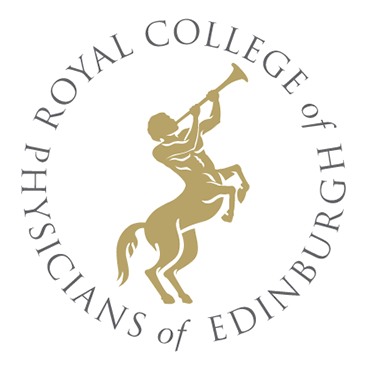
The Consultation Letters of Dr William Cullen (1710-1790) at the Royal College of Physicians of Edinburgh
[ID:3003] From: Dr William Mackinnon Fraser (5th of Balnain) / To: Dr William Cullen (Professor Cullen) / Regarding: Mr William Bruce (of Tobago; of Stenhouse; Sir William Bruce of Stenhouse, 7th Bt, after 1795) (Patient) / 22 March 1787 / (Incoming)
Letter from William Fraser in Bath, concerning Mr (William) Bruce, whose illness he believes may be rooted in his liver, rather than from the effects of an intermittent fever. He is only able to take the waters externally. Fraser also discusses the nosology of cutaneous diseases, which 'we have frequent opportunities here of seeing', including lepra graecorum, which matched Cullen's definition, and two diseases mentioned by Hillary and Hendy, one of elephantiasis and the other of 'leprosy of the joints'. (His own Caribbean background may give him an interest in the subject).
- Facsimile
- Normalized Text
- Diplomatic Text
- Metadata
- Case
- People
- Places
Facsimile
There are 4 images for this document.
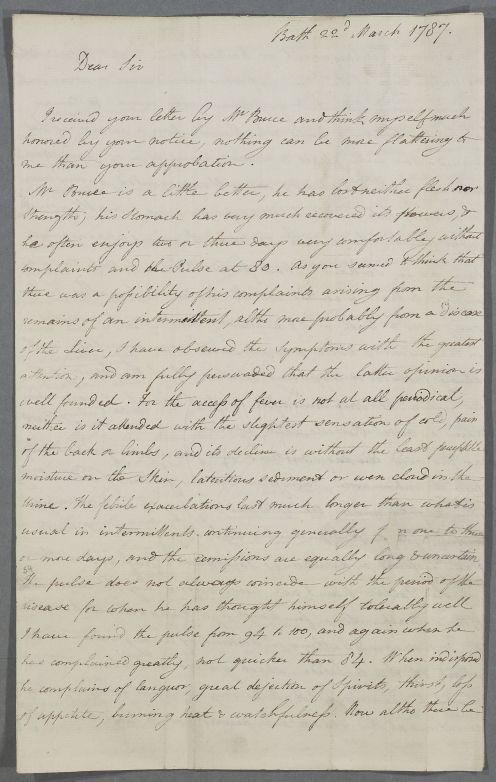
[Page 1]
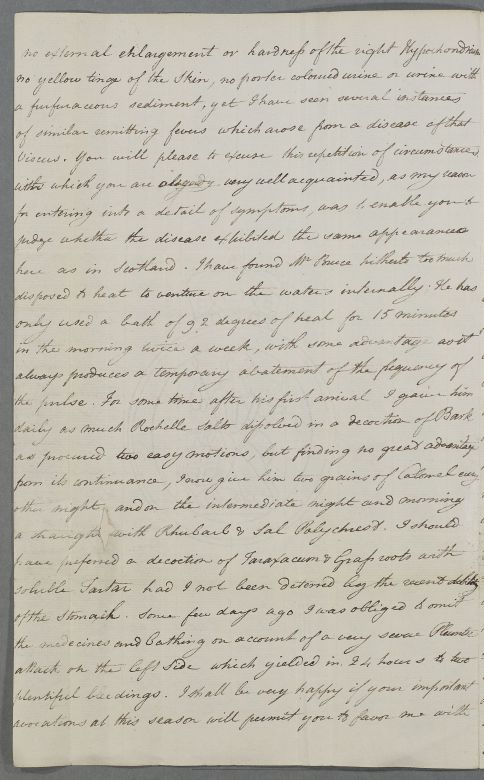
[Page 2]
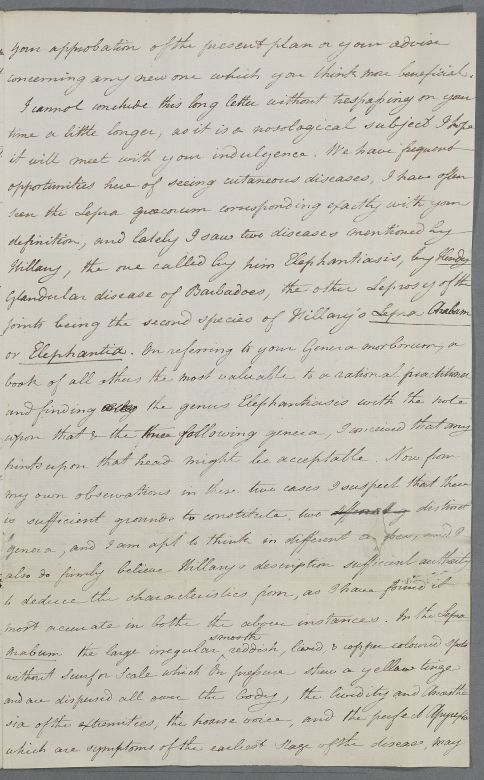
[Page 3]
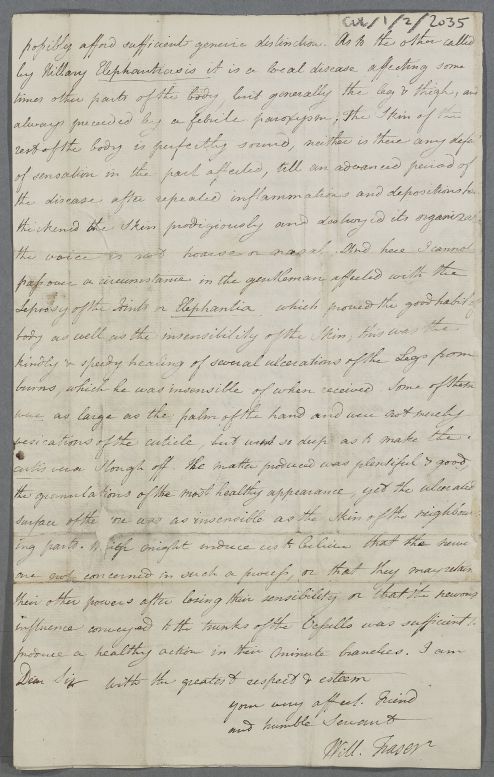
[Page 4]
Metadata
| Field | Data |
|---|---|
| DOC ID | 3003 |
| RCPE Catalogue Number | CUL/1/2/2035 |
| Main Language | English |
| Document Direction | Incoming |
| Date | 22 March 1787 |
| Annotation | None |
| Type | Authorial original |
| Enclosure(s) | No enclosure(s) |
| Autopsy | No |
| Recipe | No |
| Regimen | No |
| Letter of Introduction | No |
| Case Note | No |
| Summary | Letter from William Fraser in Bath, concerning Mr (William) Bruce, whose illness he believes may be rooted in his liver, rather than from the effects of an intermittent fever. He is only able to take the waters externally. Fraser also discusses the nosology of cutaneous diseases, which 'we have frequent opportunities here of seeing', including lepra graecorum, which matched Cullen's definition, and two diseases mentioned by Hillary and Hendy, one of elephantiasis and the other of 'leprosy of the joints'. (His own Caribbean background may give him an interest in the subject). |
| Manuscript Incomplete? | No |
| Evidence of Commercial Posting | No |
Case
Cases that this document belongs to:
| Case ID | Description | Num Docs |
|---|---|---|
| [Case ID:1818] |
Case of Mr William Bruce of Stenhouse, who lost his health while long resident in Tobago and who suffers from fevers and other weakness since returning to Scotland. |
4 |
People linked to this document
| Person ID | Role in document | Person |
|---|---|---|
| [PERS ID:4258] | Author | Dr William Mackinnon Fraser (5th of Balnain) |
| [PERS ID:1] | Addressee | Dr William Cullen (Professor Cullen) |
| [PERS ID:5624] | Patient | Mr William Bruce (of Tobago; of Stenhouse; Sir William Bruce of Stenhouse, 7th Bt, after 1795) |
| [PERS ID:4258] | Patient's Physician / Surgeon / Apothecary | Dr William Mackinnon Fraser (5th of Balnain) |
| [PERS ID:1] | Patient's Physician / Surgeon / Apothecary | Dr William Cullen (Professor Cullen) |
| [PERS ID:5629] | Other Physician / Surgeon | Dr William Hillary |
| [PERS ID:5633] | Other Physician / Surgeon | Dr James Hendy (jr.) |
Places linked to this document
| Role in document | Specific Place | Settlements / Areas | Region | Country | Global Region | Confidence |
|---|---|---|---|---|---|---|
| Place of Writing | Bath | South-West | England | Europe | certain | |
| Destination of Letter | Edinburgh | Edinburgh and East | Scotland | Europe | inferred | |
| Mentioned / Other | Barbados | West Indies | certain | |||
| Mentioned / Other | Scotland | Europe | certain |
Normalized Text
I received your letter by Mr Bruce and think myself much
honored by your notice, nothing can be more flattering to
me than your approbation.
Mr Bruce is a little better, he has lost neither flesh nor
strength; his stomach has very much exercised its powers, &
he often enjoys two or three days very comfortably without
complaints and the Pulse at 80. As you seemed to think that
there was a possibility of his complaints arising from the
remains of an intermittent, altho more probably from a disease
of the Liver, I have observed the symptoms with the greatest
attention, and am fully persuaded that the latter opinion is
well founded. For the access of fever is not at all periodical.
neither is it attended with the slightest sensation of a cold, pain
of the back or limbs, and its decline is without the least perceptible
moisture on the skin, lateritious sediment or even cloud in the
urine. The febrile exacerbations last much longer than what is
usual in intermittents, continuing generally for one to three
or more days, and the remissions are equally long & uncertain.
The pulse does not always coincide with the period of the
disease for when he has thought himself tolerably well
I have found the pulse from 94 to 100, and again when he
had complained greatly, not quicker than 84. When indisposed
he complains of languor, great dejection of spirits, thirst, loss
of appetite, burning heat & watchfulness. Now altho there be
[Page 2]
no external enlargement or hardness of the right Hypochondria
no yellow tinge of the skin, no porter coloured urine or urine with
a furfuraceous sediment, yet I have seen several instances
of similar remitting fevers which arose from a disease of that
viscus. You will please to excuse this repetition of circumstances
with which you are already very well acquainted, as my reason
for entering into a detail of symptoms, was to enable you to
judge whether the disease exhibited the same appearance
here as in Scotland. I have found Mr Bruce hitherto too much
disposed to heat to venture on the waters internally. He has
only used a bath of 92 degrees of heat for 15 minutes
in the morning twice a week, with some advantage as it
always produces a temporary abatement of the frequency of
the pulse. For some time after his first arrival I gave him
daily as much Rochelle salts dissolved in a decoction of Bark
as procured two easy motions, but finding no great advantage
from its continuance, I now give him two grains of Calomel every
other night, and on the intermediate night and morning
a draught with Rhubarb & Sal Polychrest. I should
have preferred a decoction of Tanaxacum & Grass roots with
soluble Tartar had I not been deterred by the recent debility
of the stomach. Some few days ago I was obliged to omit
the medecines and bathing on account of a very severe Pleuritic
attack on the left side which yielded in 24 hours to two
plentiful bleedings. I shall be very happy if your important
avocations at this season will permit you to favor me with
[Page 3]
your approbation of the present plan or your advise
concerning any new one which you think more beneficial.
I cannot conclude this long letter without trespassing on your
time a little longer, as it is a nosological subject I hope
it will meet with your indulgence. We have frequent
opportunities here of seeing cutaneous diseases, I have often
seen the Lepra græcorum corresponding exactly with your
definition, and lately I saw two diseases mentioned by
Hillary, 1 the once called by him Elephantiasis, by Hendy
Glandular disease of Barbadoes, 2 the other Leprosy of the
joints being the second species of Hillary's Lepra Arabum
or Elephantia. On referring to your Genera morborum, 3 a
book of all others the most valuable to a rational practitioner
and finding only the genus Elephantiasis with the note
upon that & the three following genera, I conceived that any
hints upon that head might be acceptable. Now from
my own observations in these two cases I suspect that there
is sufficient grounds to constitute two different distinct
genera, and I am apt to think in different {illeg}, and I
also do firmly believe Hillary's description sufficient authority
to deduce the characteristics from, as I have found it
most accurate in both the above instances. In the Lepra
arabum the large irregular ↑smooth↑ reddish, livid, & copper-coloured spots
without scurf or scale which on pressure shew a yellow tinge
and are dispersed all over the body, the lividity and Anæsthe¬
sia of the extremities, the hoarse voice, and the perfect Apyrexia
which are symptoms of the earliest stage of the disease, may
[Page 4]
possibly afford sufficient genuine distinction. As to the other called
by Hillary Elephantiasis it is a local disease affecting some
times other parts of the body, but generally the leg & thigh, and
always preceeded by a febrile paroxysm. The skin of the
rest of the body is perfectly sound, neither is there any defect
of sensation in the part affected, till an advanced period of
the disease after repeated inflammations and depositions have
thickened the skin prodigiously and destroyed its organization
the voice is not hoarse or nasal. And here I cannot
pass over a circumstance in the gentleman affected with the
Leprosy of the Joints or Elephantia which proved the good habit of
body as well as the insensibility of the skin, this was the
kindly & speedy healing of several ulcerations of the Legs from
burns, which he was insensible of when received. Some of these
were as large as the palm of the hand and were not merely
vesications of the cuticle, but went so deep as to make the
cutis vera slough off. The matter produced was plentiful & good,
the granulations of the most healthy appearance, yet the ulcerated
surface of the sore was as insensible as the skin of the neighbour¬
ing parts. [Which?] might induce us to believe that the nerves
are not concerned in such a process, or that they may retain
their other powers after losing their sensibility or that the nervous
influence conveyed to the trunks of the Vessells was sufficient to
produce a healthy action in their minute branches. I am
Dear Sir with the greatest respect & esteem
and humble servant
Notes:
1: William Hillary, Observations on the Changes of the Air and the Concomitant Epidemical Diseases, in the Island of Barbadoes. To which is added a Treatise on the putrid Bilious Fever, commonly called the Yellow Fever; and such other Diseases as are indigenous or endemial, in the West India Islands, or in the Torrid Zone (London, 1759).
2: James Hendy, A Treatise on the Glandular Disease of Barbadoes: Proving It to Be Seated in the Lymphatic System (London, 1784).
3: William Cullen, Synopsis nosologiae methodicae : sistens morborum classes genera at species cum harum ex Sauvagesio Synonomis (1769; 1771; 1780; 1785)
Diplomatic Text
I received your letter by Mr Bruce and think myself much
honored by your notice, nothing can be more flattering to
me than your approbation.
Mr Bruce is a little better, he has lost neither flesh nor
strength; his stomach has very much exercised its powers, &
he often enjoys two or three days very comfortably without
complaints and the Pulse at 80. As you seemed to think that
there was a possibility of his complaints arising from the
remains of an intermittent, altho more probably from a disease
of the Liver, I have observed the symptoms with the greatest
attention, and am fully persuaded that the latter opinion is
well founded. For the access of fever is not at all periodical.
neither is it attended with the slightest sensation of a cold, pain
of the back or limbs, and its decline is without the least perceptible
moisture on the skin, lateritious sediment or even cloud in the
urine. The febrile exacerbations last much longer than what is
usual in intermittents, continuing generally for one to three
or more days, and the remissions are equally long & uncertain.
The pulse does not always coincide with the period of the
disease for when he has thought himself tolerably well
I have found the pulse from 94 to 100, and again when he
had complained greatly, not quicker than 84. When indisposed
he complains of languor, great dejection of spirits, thirst, loss
of appetite, burning heat & watchfulness. Now altho there be
[Page 2]
no external enlargement or hardness of the right Hypochondria
no yellow tinge of the skin, no porter coloured urine or urine with
a furfuraceous sediment, yet I have seen several instances
of similar remitting fevers which arose from a disease of that
viscus. You will please to excuse this repetition of circumstances
with which you are already very well acquainted, as my reason
for entering into a detail of symptoms, was to enable you to
judge whether the disease exhibited the same appearance
here as in Scotland. I have found Mr Bruce hitherto too much
disposed to heat to venture on the waters internally. He has
only used a bath of 92 degrees of heat for 15 minutes
in the morning twice a week, with some advantage as it
always produces a temporary abatement of the frequency of
the pulse. For some time after his first arrival I gave him
daily as much Rochelle salts dissolved in a decoction of Bark
as procured two easy motions, but finding no great advantage
from its continuance, I now give him two grains of Calomel every
other night, and on the intermediate night and morning
a draught with Rhubarb & Sal Polychrest. I should
have preferred a decoction of Tanaxacum & Grass roots with
soluble Tartar had I not been deterred by the recent debility
of the stomach. Some few days ago I was obliged to omit
the medecines and bathing on account of a very severe Pleuritic
attack on the left side which yielded in 24 hours to two
plentiful bleedings. I shall be very happy if your important
avocations at this season will permit you to favor me with
[Page 3]
your approbation of the present plan or your advise
concerning any new one which you think more beneficial.
I cannot conclude this long letter without trespassing on your
time a little longer, as it is a nosological subject I hope
it will meet with your indulgence. We have frequent
opportunities here of seeing cutaneous diseases, I have often
seen the Lepra græcorum corresponding exactly with your
definition, and lately I saw two diseases mentioned by
Hillary, 1 the once called by him Elephantiasis, by Hendy
Glandular disease of Barbadoes, 2 the other Leprosy of the
joints being the second species of Hillary's Lepra Arabum
or Elephantia. On referring to your Genera morborum, 3 a
book of all others the most valuable to a rational practitioner
and finding only the genus Elephantiasis with the note
upon that & the three following genera, I conceived that any
hints upon that head might be acceptable. Now from
my own observations in these two cases I suspect that there
is sufficient grounds to constitute two different distinct
genera, and I am apt to think in different {illeg}, and I
also do firmly believe Hillary's description sufficient authority
to deduce the characteristics from, as I have found it
most accurate in both the above instances. In the Lepra
arabum the large irregular ↑smooth↑ reddish, livid, & copper-coloured spots
without scurf or scale which on pressure shew a yellow tinge
and are dispersed all over the body, the lividity and Anæsthe¬
sia of the extremities, the hoarse voice, and the perfect Apyrexia
which are symptoms of the earliest stage of the disease, may
[Page 4]
possibly afford sufficient genuine distinction. As to the other called
by Hillary Elephantiasis it is a local disease affecting some
times other parts of the body, but generally the leg & thigh, and
always preceeded by a febrile paroxysm. The skin of the
rest of the body is perfectly sound, neither is there any defect
of sensation in the part affected, till an advanced period of
the disease after repeated inflammations and depositions have
thickened the skin prodigiously and destroyed its organization
the voice is not hoarse or nasal. And here I cannot
pass over a circumstance in the gentleman affected with the
Leprosy of the Joints or Elephantia which proved the good habit of
body as well as the insensibility of the skin, this was the
kindly & speedy healing of several ulcerations of the Legs from
burns, which he was insensible of when received. Some of these
were as large as the palm of the hand and were not merely
vesications of the cuticle, but went so deep as to make the
cutis vera slough off. The matter produced was plentiful & good,
the granulations of the most healthy appearance, yet the ulcerated
surface of the sore was as insensible as the skin of the neighbour¬
ing parts. [Which?] might induce us to believe that the nerves
are not concerned in such a process, or that they may retain
their other powers after losing their sensibility or that the nervous
influence conveyed to the trunks of the Vessells was sufficient to
produce a healthy action in their minute branches. I am
Dear Sir with the greatest respect & esteem
and humble servant
Notes:
1: William Hillary, Observations on the Changes of the Air and the Concomitant Epidemical Diseases, in the Island of Barbadoes. To which is added a Treatise on the putrid Bilious Fever, commonly called the Yellow Fever; and such other Diseases as are indigenous or endemial, in the West India Islands, or in the Torrid Zone (London, 1759).
2: James Hendy, A Treatise on the Glandular Disease of Barbadoes: Proving It to Be Seated in the Lymphatic System (London, 1784).
3: William Cullen, Synopsis nosologiae methodicae : sistens morborum classes genera at species cum harum ex Sauvagesio Synonomis (1769; 1771; 1780; 1785)
XML
XML file not yet available.
Feedback
Send us specfic feeback about this document [DOC ID:3003]
Please note that the Cullen Project team have now disbanded but your comments will be logged in our system and we will look at them one day...

